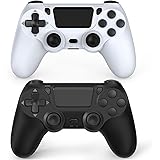Mastering PC Gaming: An Expert Guide to Selecting the Best Controller
For many avid gamers, the precision of a mouse and keyboard remains the undisputed king, yet the immersive fluidity offered by a dedicated gamepad is indispensable for certain genres and playstyles. While the video above provides a concise overview of top contenders, understanding the intricate nuances of each peripheral empowers you to make an informed decision tailored to your specific gaming ecosystem. This comprehensive guide delves deeper into the technological advancements and ergonomic considerations defining the modern PC gaming controller landscape, ensuring you equip yourself with the ultimate input device.
The evolution of the PC gaming controller has been marked by significant innovations, transitioning from rudimentary joysticks to highly sophisticated, customizable instruments. Contemporary gamepads offer a compelling blend of tactile feedback, ergonomic design, and advanced connectivity options, transforming the way players engage with their favorite titles. Identifying the ideal controller for your setup involves assessing factors like build quality, input responsiveness, customization capabilities, and compatibility across your diverse game library. Let us explore the critical aspects that differentiate a good controller from an exceptional one.
Evaluating Key Characteristics of a Superior PC Gaming Controller
Selecting the optimal PC gaming controller requires a meticulous assessment of several technical and ergonomic attributes that significantly influence gameplay. Beyond superficial aesthetics, the internal architecture and tactile components dictate the user experience across demanding titles. Understanding these core characteristics allows gamers to look past marketing claims and identify true performance differentiators. A deep dive into these elements reveals why certain controllers achieve revered status among the gaming community.
The journey to finding the perfect gamepad often involves a trade-off between various desirable features and budgetary constraints. However, prioritizing specific functionalities based on your predominant gaming genres and personal comfort can streamline the decision-making process. This section breaks down the essential qualities every discerning PC gamer should scrutinize when evaluating potential controller upgrades. Each element contributes distinctively to the overall control fidelity and long-term usability of the device.
1. Ergonomics and Build Quality: The Foundation of Comfort
The physical design of a PC gaming controller profoundly impacts long-term comfort and playability, especially during extended gaming sessions. Controllers like the Xbox Wireless Controller Series 2 exemplify superior ergonomics, conforming naturally to the hand’s contours and reducing strain on wrists and fingers. The balance of weight is another crucial aspect; while a lighter controller, such as the Logitech F310, might appeal for portability, a controller with a substantial, well-distributed heft often conveys a sense of premium construction and durability, as observed with the Elite Series 2.
Furthermore, the material composition and construction integrity are paramount for longevity and consistent performance. High-quality plastics, reinforced internal structures, and robust button mechanisms contribute to a controller’s resilience against repetitive stress and accidental impacts. A tactile assessment of grip textures, button travel, and joystick resistance can reveal much about the engineering precision, ensuring the device withstands thousands of hours of intense gameplay. Gamers frequently find that investing in a well-built controller minimizes the need for premature replacements due to wear and tear.
2. Responsiveness and Precision: The Core of Performance
Input lag, a critical factor for competitive gamers, represents the delay between a physical input and its corresponding action onscreen; minimizing this latency is vital for high-stakes gameplay. Wired controllers, such as the Razer Wolverine Ultimate, traditionally offer the lowest input lag due leveraging a direct USB connection, providing an uncompromised link to the PC. However, advancements in wireless protocols, like Microsoft’s Xbox Wireless technology and Bluetooth compatibility (standardized in Xbox Wireless Controllers after 2016), have significantly narrowed this performance gap, making wireless options increasingly viable for demanding players.
The quality of analog sticks and D-pads directly influences directional accuracy and fine motor control. High-precision analog sticks with minimal dead zones and consistent resistance are crucial for nuanced movements in titles ranging from first-person shooters to racing simulators. The D-pad, often overlooked, is particularly vital for fighting games and platformers, where crisp, distinct directional inputs are paramount. The original Xbox 360 gamepad’s D-pad, for instance, was frequently criticized for its mushy feel, a flaw significantly rectified in subsequent Xbox Wireless Controller iterations and premium alternatives like the Astro C40 TR.
3. Customization and Modularity: Tailoring Your Experience
Advanced PC gaming controllers distinguish themselves through their extensive customization options, allowing players to meticulously fine-tune inputs and physical configurations. Modular designs, as prominently featured in the Astro C40 TR and both Xbox Elite Wireless Controller Series, enable the physical rearrangement of components like thumbsticks and D-pads. This flexibility caters to diverse ergonomic preferences, allowing a player to configure the layout that best suits their hand size and gaming style, potentially swapping a left thumbstick for a D-pad to emulate an Xbox-style layout on a PS4-esque form factor.
Beyond physical modifications, sophisticated software suites bundled with controllers like the Microsoft Xbox Elite Wireless Controller Series 2 provide unparalleled digital customization. These applications allow for granular adjustments of trigger actuation points, stick sensitivity curves, button remapping, and the creation of multiple custom profiles for different game genres or player preferences. The ability to program paddle buttons on the back of controllers, a hallmark of the Elite series and Razer Wolverine Ultimate, offers additional accessible inputs without repositioning the thumbs, significantly enhancing competitive advantage in complex titles.
4. Connectivity and Compatibility: Seamless Integration
Modern PC gaming controllers offer diverse connectivity options, predominantly wired USB connections or wireless Bluetooth/proprietary radio frequency (RF) links. Wired connections, exemplified by the Razer Wolverine Ultimate’s 10-foot braided micro USB cable, guarantee zero latency and eliminate concerns about battery life, proving ideal for dedicated desktop setups. Conversely, wireless controllers offer unparalleled freedom of movement, enhancing couch-gaming experiences or reducing cable clutter for a cleaner setup.
Bluetooth compatibility, integrated into the Xbox Wireless Controller since 2016 and a key feature of the Elite Series 2, facilitates broad compatibility with a multitude of devices, including mobile platforms for cloud gaming services like Project XCloud and Apple Arcade. Proprietary wireless technologies, such as Microsoft’s Xbox Wireless, offer a dedicated, low-latency connection often requiring a specific USB adapter for PCs, but typically deliver a more robust and interference-resistant signal than standard Bluetooth. Ensuring your chosen controller supports the necessary drivers and software for Windows (e.g., Razer Synapse 3, Astro C40 TR software) is crucial for full functionality and customization.
Spotlight on Elite PC Gaming Controller Innovations
The premium segment of the PC gaming controller market showcases the pinnacle of input technology, delivering features previously exclusive to professional esports athletes. These high-end devices are engineered to provide a tangible competitive edge through superior precision, extensive customization, and refined build quality. While the initial investment is substantial, often reaching upwards of $180 for models like the Xbox Elite Wireless Controller Series 2, the enhanced control and durability offer significant long-term value for serious gamers.
Innovations such as magnetic interchangeable components, adjustable thumbstick tension, and hair-trigger locks fundamentally transform the gaming experience, allowing players to react faster and execute complex maneuvers with greater accuracy. The integration of advanced haptic feedback systems and on-board profile storage further elevates these controllers beyond standard gamepads. For those who consider gaming a serious endeavor, these elite controllers represent a critical investment in performance enhancement and ergonomic longevity, justifying their higher price point through unparalleled fidelity and adaptability.
The Xbox Elite Wireless Controller Series 2: A Benchmark in Performance
Often lauded as the industry benchmark, the Xbox Elite Wireless Controller Series 2 encapsulates a suite of features designed for peak performance and unparalleled customization. This controller’s near-endless configuration options empower players to fine-tune every aspect of their input, from the resistance of thumbsticks to the sensitivity of triggers. The adjustable thumbstick tension, a significant upgrade over its predecessor, provides an unprecedented level of control, allowing users to dial in their preferred feel for different game genres, from the precise aiming required in competitive shooters to the fluid movements needed in open-world adventures.
Beyond its acclaimed customization, the Series 2 boasts a robust build quality and practical enhancements, including a substantial 40-hour rechargeable battery, a crucial improvement for extended wireless gameplay. The included carrying case, which doubles as a charging dock, underscores its premium utility. Despite its $180 price tag, representing nearly four times the cost of a standard Xbox One controller, the Elite Series 2 consistently demonstrates its worth through superior tactile feedback, durable construction, and comprehensive adaptability. This makes it a compelling choice for serious gamers prioritizing performance and extreme personalization in their PC gaming controller.
Razer Wolverine Ultimate: Tactile Feedback Redefined
The Razer Wolverine Ultimate stands out in the premium controller segment, particularly for its innovative approach to button mechanics, mimicking the satisfying click of a mechanical mouse switch. This distinct tactile feedback on the face buttons (A, B, X, Y) offers a level of responsiveness and auditory confirmation that membrane-based buttons cannot replicate. This seemingly minor detail can significantly enhance the sensory experience and improve input accuracy, particularly in fast-paced or rhythm-based games where precise button presses are paramount.
While its wired-only connection might deter some, the 10-foot braided micro USB cable ensures a stable, lag-free experience, a trade-off many competitive players are willing to accept for optimal performance. The Wolverine Ultimate also integrates many luxury features found in other elite controllers, such as swappable D-pads and customizable back paddles, which offer additional programmable inputs for complex commands. Although it requires a separate Razer app for PC customization (distinct from Synapse 3), its unique blend of mechanical button feel and robust feature set positions it as a strong contender for players who prioritize specific tactile feedback in their PC gaming controller.









